List of creatures in Primeval
The following is a complete list of creatures from the universe of ITV science fiction television series Primeval and also any spin-off media, including Primeval: New World ("PNW"). The series includes various imaginary species which are not native to the series setting, with some being prehistoric and others being futuristic. Various creatures were designed with some artistic license, for dramatic effect.[1] A number of creatures from the Walking with... series were also reimagined for dramatic effect.
In 2007 Character Options announced they would create Primeval action figures, including both a flying Rex and a large plush toy Rex, Future Predators, Hesperornis and dodos.
A
Albertosaurus
| Albertosaurus | |
|---|---|
 | |
| Home era | Late Cretaceous |
| First appearance (Primeval: New World) | Episode 1.1 |
| Last appearance (Primeval: New World) | Episode 1.13 |
| Number | 1 |
| Humans killed | 2 (counting alternate version of Mac Rendall) |
| Returned to era? | 1.1 – Returned through anomaly on its own. 1.13 – Unknown |
Albertosaurus is a predatory theropod dinosaur, a member of the Tyrannosauridae. In Primeval: New World, an Albertosaurus killed and devoured Brooke, Evan Cross' wife and an alternate timeline version of Mac Rendall. In the series, its preorbital horns are greatly enlarged, similar to those of a Carnotaurus with similar skin textures. Evan encounters the same Albertosaurus as a hallucination after accidentally ingesting the snot of a Pachycephalosaurus. On close inspection, the Albertosaurus can be recognised by its missing right arm, and its body was covered in numerous old cuts and slashes.
Allosaurus
| Allosaurus | |
|---|---|
 | |
| Home era | Late Jurassic |
| Appears in | The Lost Island |
| First appearance (Primeval) | Episode 1.1 |
| Last appearance (Primeval) | Episode 3.10 |
| Number | 7 |
| Humans killed | 0 |
| Returned to era? | No |
Allosaurus is a large Theropod dinosaur that lived in North America during the Late Jurassic. Allosaurus was a large carnivorous dinosaur with a length of up to 12 m (39 ft), and stood up to 5 m (16 ft) tall. The animal had a skull that measured 1 m (4 ft) long, with a pair of blunt crests just above its eyes, in the orbital region. It had a strong S-shaped neck, and had vertebrae that was different from those of other dinosaurs
Allosaurus also had a large powerful jaw with long, sharp, serrated teeth that were 51–102 mm (2–4 in) long. These teeth were curved inward, shaped like a "D" to help secure its prey. It had a bulky body, a massive tail and thick bones. Its arms were short and had three fingered hands, with sharp claws that were up to 152 mm (6 in) long. Allosaurus was one of the largest meat-eating dinosaurs of the Late Jurassic, 156-145 MYA, and was also one of the largest predators until the tyrannosaurs appeared 50 million years later.
Ammonite
| Ammonite | |
|---|---|
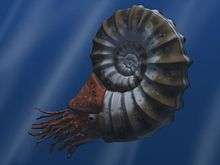 | |
| Home era | Cretaceous or earlier |
| First appearance (Primeval) | Episode 1.1 |
| Last appearance (Primeval) | Episode 2.7 |
| Returned to era? | No. Died out of water. |
Ammonites are a group of marine animals of the subclass Ammonoidea in the class Cephalopoda, phylum Mollusca. Ammonites' closest living relative is probably not the modern Nautilus (which they outwardly resemble), but rather the subclass Coleoidea (octopus, squid, and cuttlefish). Their fossil shells usually take the form of planispirals, although there were some helically spiralled and non-spiralled forms (known as "heteromorphs"). Many Ammonites lived in the open water of ancient seas, rather than at the sea bottom. Many of them are thought to have been good swimmers with flattened, discus-shaped, streamlined shells. Ammonites preyed on fish, crustaceans and other small creatures; while they themselves were preyed upon by marine reptiles.
Helen Cutter leaves Ammonites as calling cards on Nick Cutter's desk, and on Stephen Hart's grave in episode 2.7.
Anatotitan
| Anatotitan | |
|---|---|
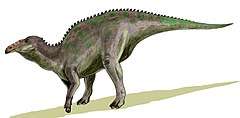 | |
| Home era | Late Cretaceous |
| Appears in | Extinction Event |
| Number | A large herd |
In Extinction Event, the first large dinosaurs the kidnapped team spot are Anatotitan, which are described as large hadrosaurs that move in large herds, stampeding whenever they are threatened by a predator such as the Tyrannosaurus. They were said to be a yellow-brown color with dark brown camouflage stripes down their back, similar to the Iguanodon in The Lost Island.
Ankylosaurus
| Ankylosaurus | |
|---|---|
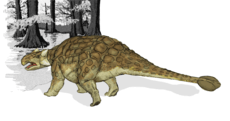 | |
| Home era | Late Cretaceous |
| Appears in | Extinction Event |
| Number | At least one in the present, two in the Cretaceous |
In Extinction Event, Ankylosaurs are seen a couple of times, at first one plods harmlessly through the team's campsite, and prove to be resistant to gunfire, and later Jenny and the soldiers accompanying her are almost killed after an angered Ankylosaurus hits the car they are in with its tail club. A mother and baby are also seen in the Cretaceous.
Anurognathus
| Anurognathus | |
|---|---|
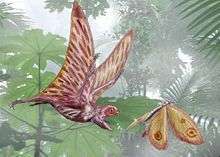 | |
| Home era | Late Jurassic |
| First appearance (Primeval) | Episode 1.5 |
| Last appearance (Primeval) | Episode 5.5 |
| Number | Dozens |
| Humans killed | 5 |
| Returned to era? | No. All killed in episode 1.5, still at large in episode 5.5. |
Anurognathus was a tiny pterosaur that had a short head with pin-like teeth for catching insects, and although it traditionally is ascribed to the long tailed pterosaur group, its tail was comparatively short, allowing it more manoeuvrability for hunting in woodland. Anurognathus lived in the Late Jurassic period, 130 million years ago and had a wingspan of 50 cm (20 in) and a 50 cm (20 in) long body (skull included), and it could not have weighed more than a few grams (although the pterosaurs that appear in episode 5.5 are considerably longer, fatter, and heavier, and could not have weighed so little). Despite this they prove to be creatures of devastating violence.[2]
Anurognathus live like a flying piranha fish, with an amazingly keen sense of smell able to detect blood from hundreds of feet away. A swarm can strip flesh from bones in minutes. They also swarm in huge flocks and overcome prey through weight in numbers.[2]
This fictional species of Anurognathus evolved from the Jurassic species Anurognathus ammoni which lived about 150 million years ago and had small needle like teeth for hunting insects. This evolved form has slicing teeth for taking lumps of flesh off large dinosaurs. This behaviour may be slightly based on the theory that a similar anurognathid pterosaur, Jeholopterus, was a hematophagous creature, like the modern vampire bat.[3] The creatures seen in the series were re-imagined from the creatures in Walking with Dinosaurs by the producers for dramatic effect.[1]
In episode 5.5 a flock appears at the New Dawn power station. They attack Matt and Emily and later kill two Prospero guards. They later attack and kill April. What happened to them is unknown.
Arthropleura
| Arthropleura | |
|---|---|
 | |
| Home era | Carboniferous |
| First appearance (Primeval) | Episode 1.2 |
| Last appearance (Primeval) | Episode 2.7 |
| Number | 2 |
| Humans killed | 2 |
| Returned to era? | No, both killed in present. |
Arthropleura was a 2–3 m (7–10 ft) long (about 6 m (20 ft) long in the series) relative of centipedes and millipedes, native to the Upper Carboniferous of Britain and the United States. It was the largest known land invertebrate of all time and grew so large because of the high percentage of oxygen in the Earth's atmosphere at that time. A burrower, they have poor eyesight but have excellent sense of smell and touch. One appears in the second episode. Although not a carnivore, they have powerful pincers and venomous bite and can easily be provoked into attacking.[4] For dramatic effect, the Arthropleura in episode 1.2 was heavily re-imagined as it was venomous, larger than the real animal and highly aggressive.[1]
Symptoms of the Arthropleura poisoning include uncontrolled shaking, anaphylaxis and short term memory loss in recovered patients.
Once bitten the venom then begins to slowly attack the central nervous system, not so far removed from modern biochemistry as to be totally ineffective, and any enzyme inhibitor would be detrimental to an extent. However, as the Arthropleura are detritus eaters they make no attempt to eat their victims. Fortunately the hospital staff discovered that the venom has a modern-day equivalent, thus producing an anti-venom.[4]
An Arthropleura also reappeared in the series finale of Series 2 as one of the many creatures captured by Leek. When the security system holding it failed, it ran amok, although how it had survived thus far without the carboniferous atmosphere that it needed to live, remains a mystery.
Arthropleura also featured in the advertising campaign for the series, appearing in The London Paper on 16 February 2007. The Arthropleura portrayed here is different from the creatures seen in the fossil record, in addition to the Arthropleura in Walking with Monsters as well as in Prehistoric Park, re-imagined by the producers to make it scarier.[1]
Australopithecus
| Australopithecus | |
|---|---|
| Species | Australopithecus afarensis |
| Home era | Pliocene |
| Appears in | Episode 3.10 |
| Returned to era? | Never left their own time |
Australopithecus are believed to be the ancestors of modern-day humans.
Helen Cutter believed the only way to stop the destruction of life on earth was to stop humans from evolving, so she attempted to wipe out our ancestors. She began by poisoning the members of the "First Family" in episode 3.10, but is killed herself before she can complete her plan. Danny Quinn later found several more living in the Rift Valley as he attempted to find his way back to the anomaly.
B
Badger-like mammal
| Badger-like mammal | |
|---|---|
| Appears in | The Lost Island |
| Number | 1 |
In The Lost Island, the team are marooned in the Cretaceous, when they run into a mammal described as being similar to a badger. It briefly snarls at the team, and then runs off. It turns out to have been later feasting on a dead Iguanodon calf.
Brontoscorpio
| Brontoscorpio | |
|---|---|
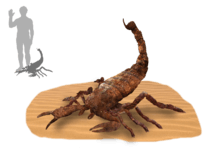 | |
| Home era | Silurian |
| First appearance (Primeval: New World) | The Sound of Thunder: Part 1 |
| Last appearance (Primeval: New World) | The Sound of Thunder: Part 2 |
| Number | 1 |
| Humans killed | more than 1 |
| Returned to era? | Yes |
Brontoscorpio's body is approximately eight feet long, and it can scale on walls and other surfaces like a spider. The body is covered in a hard exoskeleton, the only soft spot it has is its mouth. The exoskeleton makes tasers ineffective against Brontoscorpio, and even when shot directly into its mouth, tasers sometimes have little effect on Brontoscorpio (but, other times, can knock it out for a few moments). Brontoscorpio is known to attack victims with its stinger to incapacitate them with its venom, and to suck out and consume its victims' internal organs after its venom kills them. Brontoscorpio also lives in burrows. Brontoscorpio has also been shown to approach prey tensed and cautiously and to momentarily back away slightly when the victim shows signs of attacking, similar to some modern day scorpions.
Burrowing insect
| Burrowing insect | |
|---|---|
| Home era | Future |
| Appears in | Episode 5.1 |
| Humans killed | 2+ |
| Returned to era? | No, all killed in explosion |
This creature is from the future, and has been encountered by Matt Anderson before, allowing him knowledge of their behaviour. Adults are 2–3 m (7–10 ft) in length. They have armoured shells, however their underbelly is softer. Their anomaly must have opened some years before and they had dug tunnels stretching all across London.
In episode 5.1, one attacked a roadworker who fell into one of its tunnels, and returned when Matt, Becker and Abby arrived, attempting to attack them as they fired their EMDs, which did not affect it. It then attacked a man at a barbecue, which alerted the team who tried to use lethal weapons to bring it down, only for the creature to drag Connor into its tunnel. As the team located its nest, it succumbed to the damage done to it and died, leaving Connor to find dozens more inside the building. Connor filled the building with gas and escaped with Matt as the building was blown up in order to exterminate them.
C
Camouflage Beast
| Camouflage Beast | |
|---|---|
| Home era | Future |
| Appears in | Episode 3.2 |
| Humans killed | 3 |
| Returned to era? | Fell back through the anomaly after being shot by Danny Quinn |
In episode 3.2, the Camouflage Beast (it is never given a name on screen) is the major, and only, creature. It has been shown on the ITV website that this creature is based heavily on the Madagascan aye-aye which is seen as a symbol of death in its homeland. The creature may speak some kind of language, as it makes a kind of hissing, whispering noise when it is alone.
It was responsible for the disappearance of two boys 14 years before the present, including Patrick Quinn, and leaving Ryan Mason the only survivor. In the present day it was being fed raw meat by a girl in order to keep it from eating neighbouring pets. When the team arrived at the now abandoned house they could not find the creature due to its camouflage ability, and later it attacked Abby when she was alone. Abby later followed it and discovered the girl feeding it. She and Ryan were in the house when it attacked again, however when the others arrived it killed a real estate agent. It attacked Danny Quinn, and it went through its anomaly when it reopened, however it came back, only to be shot several times by Danny as it fell back through, possibly dead.
In episode 4.7 Patrick Quinn, who in fact survived and went through the anomaly, stated that the Camouflage beasts kept coming for him and was forced to kill them to survive. The trauma caused him to also see humans as animals, and became convinced that killing humans is not any different from killing animals.
Coelurosauravus
| Coelurosauravus | |
|---|---|
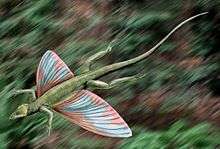 | |
| Home era | Permian |
| First appearance (Primeval) | Episode 1.1 |
| Number | 1 |
| Returned to era? | No, kept as a pet |
A male Coelurosauravus, named "Rex", entered the present in the series' premiere, and despite attempts to send it back to the Permian, was adopted by Abby and quickly became a mascot for the team. Coelurosauravus is incorrectly shown to be capable of powered flight rather than simple gliding, and shown to be far larger than its real size of 30 cm (12 in). Its head crest is also entirely speculative.
In episode 1.1, Rex was kept by Ben Trent after he came through the Permian anomaly, and was assumed to be the flying lizard Draco volans until Abby Maitland arrived and said he wasn't. After encountering a Scutosaurus and a group of others, Rex was taken to the Home Office to be examined. He escaped from the lab and flew around the building, and Abby kept him from leaving. He was returned through the Permian anomaly by Nick Cutter, but came back to the present and was taken back to Abby's flat in secret. Abby had to adjust the temperature of her flat so that it was similar to his own environment, and Connor Temple discovered him, but agreed to not reveal Rex's presence. Rex escaped from the flat in episode 1.5, and was accidentally transported to a golf course where Connor tried to catch him. Rex ran off as they were attacked by a Pteranodon, and Abby pleaded to Cutter to let her keep him. Rex was later found and returned to the flat.
In episode 2.2, Rex took an instant dislike to Connor's new girlfriend Caroline Steel, attempting to bite her. In episode 2.4 he was left in the freezer by Caroline, and was found by Abby before he completely froze. By the next day he had recovered. In episode 2.5 Caroline attempted to capture Rex by leaving food out for him, and he flew around the flat trying to avoid her but was knocked down by a tennis racket. Caroline took Rex to Oliver Leek, who kept him in his creature prison. In episode 2.7 he was released along with the other creatures, and found a shaft to the surface which was used by the team to escape. Rex was shot by a guard, and Caroline asked to redeem herself by getting Rex out.
Rex was shown to still be living with Abby and Connor in episode 3.1, and in episode 3.6 Abby's brother Jack bet Rex during a game of poker with a friend and lost. He was put on E-Bay for sale which allowed Connor to notice what Jack had done. They attempted to get Rex back, and finally did so when Connor had Captain Becker threaten the seller. Abby brought Rex over to James Lester's flat where Connor was staying in episode 3.9, and Rex played with Connor's two Diictodon, Sid and Nancy.
During Abby and Connor's disappearance, Rex was relocated to the new ARC inside the menagerie, living alongside other creatures that hadn't been returned to their own eras, such as the Columbian Mammoth and the Dracorex. Abby reunited with Rex in episode 4.2 after she had returned and been placed in charge of the creatures. In episode 4.3 Rex escaped from the menagerie and caused the ARC to go into lockdown when he was scanned by Phillip Burton's bio-scanner. The room was drained of oxygen, and Connor managed to cancel the lockdown in time to be able to resuscitate Rex. In episode 5.4 he was in Abby's lab when the ARC was invaded by Future Beetles and flew around the ARC. Abby searched for him to rescue him before a gamma ray was released, and later returned to the menagerie.
Columbian mammoth
| Columbian mammoth | |
|---|---|
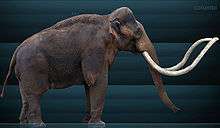 | |
| Species | Mammuthus columbi |
| Home era | Pleistocene |
| First appearance (Primeval) | Episode 2.6 |
| Last appearance (Primeval) | Episode 5.5 |
| Number | 2 |
| Humans killed | at least one |
| Returned to era? | No, kept by the ARC |
The Columbian mammoth was one of the largest of the mammoth species and also one of the largest elephants to have ever lived, measuring 4 m (13 ft), at the shoulder and weighing 10 t (9.8 long tons) with tusks 5 m (16 ft) long. It was a herbivore, with a diet consisting of varied plant life ranging from grasses to conifers. It has been estimated that a large male would have eaten approximately 300 kg (660 lb), of plant material daily. The remains of Columbian mammoths were discovered in the La Brea Tar Pits in California and this mammoth also lived in Mexico, where its remains are very common. It was one of the last members of the Megafauna to become extinct, with several specimens dating only about 7,800 years ago.
The mammoth appears in series two holding up traffic on the M25 motorway. As it desperately tries to make its way to the nearby trees, it completely destroys all the nearby cars. Using female elephant urine, the team manage to lead it into a lorry trailer and trap it, taking it back to the ARC where it was kept in a large garage. After being chased through the ARC by a Future Predator, Lester releases the mammoth which impales the predator on its tusks. Lester then jokes that his children have been wanting him to get a pet.
The mammoth was seen in the new ARC's menagerie in episode 4.2 and episode 4.4. When Philip Burton decided to have the creatures put down, Abby decided to relocate the creatures, including the mammoth, but was unable to do so. However Lester managed to blackmail Philip into forgetting the whole thing, and Lester told Abby that he thought it would have rude not to have saved the mammoth's life after it had saved him.
In episode 5.5, the anomaly on the M25 reopened and another mammoth (and possibly more) came through it.
Crested bird
| Prehistoric bird | |
|---|---|
| Home era | Late Cretaceous |
| Appears in | Extinction Event |
| Number | One captured in the present |
In Extinction Event, in an area where live specimens of Cretaceous life forms have been collected, Cutter stops to look at a tiny crested bird in a wire cage that was captured by the Russian team. One of the men describes how rare this actually is, as tiny-boned creatures rarely remain intact in fossilisation.
D
Devonian Slime Shooter
| Devonian Slime Shooter | |
|---|---|
| Home era | Devonian |
| First appearance (Primeval) | Episode 2.5 |
| Number | One |
The Devonian Slime Shooter was an object, either a plant, animal or other such organism that is found in the Devonian and shoots a foul smelling slime. It covers Helen Cutter in its slime while she is in the Devonian.
Deinosuchus
| Deinosuchus | |
|---|---|
| Home era | Late Cretaceous |
| Appears in | Fire and Water |
| Number | Two, one male and one female. |
In Fire and Water, Deinosuchus are described as "giant crocodiles" reaching up to 15 m (50 feet) in length, and that females were more dominant than males. Connor Temple and Abby Maitland lure the Deinosuchus using aerosols while Captain Becker and his men dart it with tranquillisers. They never do get them back to the past and remain in Oliver Leek's old bunker where he kept all his army of creatures.
Didelphodon
| Didelphodon | |
|---|---|
 | |
| Home era | Late Cretaceous |
| Appears in | Extinction Event |
| Number | One captured in the present |
In Extinction Event, a single Didelphodon is captured by the Russian anomaly team, and taken to a building in their camp where live specimens are taken. It is described as a hairy badger-like marsupial and is also an insectivore, as it is described crunching on live locusts.
Diictodon
| Diictodon | |
|---|---|
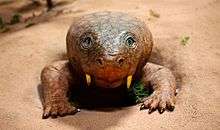 | |
| Home era | Permian |
| First appearance (Primeval) | Episode 3.3 |
| Number | Over 15 |
| Returned to era? | Yes (except two Nancy and Sid) |
Diictodon are small burrowing synapsids (proto-mammals).
A group of over fifteen individuals appear to be traversing air vents in a hospital, chewing through the electrical cables that the team will need to remove them. Abby catches one which sends of a distress signal calling them all back through the anomaly but one drops from the roof (Sid) and lands inside a trolley Connor is pushing. A single Diictodon tried to escape through an anomaly, which disappears. It later becomes apparent that Abby and Connor adopt two to keep Rex company. In episode 3.5, they are named Sid and Nancy and are living with Connor while Abby's brother, Jack, is staying.[5] When Connor was staying with James Lester the two caused him much grief.
Dimetrodon
| Dimetrodon | |
|---|---|
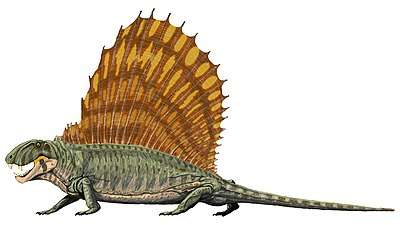 | |
| Home era | Permian |
| Appears in | Extinction Event |
| Number | Dozens in the Permian era |
In Extinction Event, Dimetrodon are encountered by Helen Cutter, Jenny Lewis and the group of men assigned to help them. They are described as being as big as alligators, basking in groups like iguanas or sea lions and also have a crippling amount of bacteria in their mouth, similar to a Komodo dragon. The group of Dimetrodon are disturbed by the team and one man is badly bitten. He never recovers from the ensuing infection, but is later killed in the Cretaceous period by a pack of Troodon.
Dodo
| Dodo | |
|---|---|
| Species | Raphus cucullatus |
| Home era | Holocene |
| Appears in | Episode 1.4 |
| Number | 4 |
| Humans killed | 1 killed by parasites |
| Returned to era? | 2 killed by parasites, the other 2 returned |
Dodos are flightless birds from the late Holocene. The dodo was found only on the islands of Mauritius. Related to pigeons and doves, they stand about 1 m (3 ft) tall, weighing about 23 kg (51 lb). Dodos have greyish plumage, a 23 cm (9.1 in) bill with a hooked point, very small wings, stout yellow legs, and a tuft of curly feathers on its rear end. The sternum is insufficient to support flight; these ground-bound birds evolved to take advantage of an island ecosystem with no predators. They live on fallen fruit and in the Primeval Universe they exist in a symbiotic relationship with the Ambalacoque tree.
The name came from the Portuguese word doudo or doido, itself a loanword from Old English (cf. English "dolt"). The name was given because the dodo apparently never tried to run or escape when hunted – hence, they were traditionally regarded as stupid. The species was hunted to extinction by the late 17th century, shortly after the first arrival of people on the dodo's native Mauritius.
They were the main focus in episode 1.4. Nick Cutter quickly realises they are just friendly and trusting, never having to deal with predators before. In reality they were as intelligent as any other bird. The dodos are themselves harmless, but some carry deadly parasites.[6]
Dracorex
| Dracorex | |
|---|---|
 | |
| Home era | Late Cretaceous |
| First appearance (Primeval) | Episode 3.7 |
| Last appearance (Primeval) | Episode 4.1 |
| Returned to era? | No. Is currently being kept in the ARC. |
Dracorex is a Cretaceous dinosaur. A promotional picture for that episode shows that it has sharp teeth, which is unlikely for a probably herbivorous creature, and two, small, wing-like sails on its back in the manner of Amargasaurus. The picture shows a very long but not forked tongue. The dinosaur also has grasping talons on its hind legs, shown in the image lashing out at the knight. The Dracorex in the series also strongly resembles the mountain dragon from the Animal Planet documentary The Last Dragon.
A female appears in episode 3.7, having lived in Medieval times before being chased through an anomaly to the present by a knight who assumed it to be a dragon. The Dracorex had been injured after having a lance driven into its side, and Abby and Becker cornered it in a strawberry patch where it collapsed of its own accord. Abby removed the stake with Becker and cared for it with Connor Temple as she helped to patch it up. It was later moved to the ARC. It escaped from the new ARC's menagerie in episode 4.1 due to an error caused by Jess Parker. It knocked Matt Anderson down in a corridor before it arrived in the hub where Jess was. Becker and soldiers arrived to contain it, but it was led into Lester's office by Matt, who left it some water. Some time later Becker tranquilised it and it was moved back to the menagerie.
E
Edaphosaurus
| Edaphosaurus | |
|---|---|
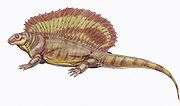 | |
| Home era | Permian |
| First appearance (Primeval) | Episode 1.1 |
| Humans killed | 0 |
Edaphosaurus is a Synapsid reptile from the Permian period, about 280 million years ago and has a sail like Dimetrodon and Spinosaurus. It was included in Connor's Database. The Edaphosaurus resembled much of what people would believe today to be a "dinosaur", however it lived during the Permian period (about 280 million years ago) which is before most dinosaurs. It was very similar to the Dimetrodon in its appearance, except there were generally smaller. They were about a foot shorter than their cousin the Dimetrodon; about 8 feet long. Like most lizards in order to walk, its body moved from side to side. This is a characteristic of animals with legs on its side rather than under it. The Edaphosaurus also had a sail on its back, but it was smaller and shaped differently from that of the Dimetrodon. Edaphosaurus were most active during the day. They were cold blooded animals which meant that their temperature was regulated by external factors (the sun, wind, rain). To get warm during the day these animals would tilt their "sails" towards the sun, and the blood going through this sail would heat up. Edaphosaurus were herbivores, meaning they only ate plants. This is evident in the teeth of the animal. Edaphosaurus teeth were much flatter than that of the Dimetrodon, and its skull was much shorter overall which indicates they had smaller jaw muscles. The Dimetrodon's skull was larger because of its big jaw muscles, and its sharp teeth that were used for shearing meat.
Embolotherium
| Embolotherium | |
|---|---|
 | |
| Home era | Late Eocene |
| First appearance (Primeval) | Episode 3.9 |
| Humans killed | 1 |
| Returned to era? | Yes |
The Embolotherium are a type of brontothere. Superficially they looked much like rhinos, although they were actually more closely related to horses. They have large but brittle horns which, in the series, are used for display during mating seasons. These beasts able to scare off big predators like Andrewsarchus. The males have a heart shaped horn on top of their noses which is about 70 cm (28 in) and the females have a some sort of stump.
A herd of Embolotherium appeared from an anomaly and caused damage in a campsite. There is one male and several females, accompanied by a baby. The male killed a quad-bike rider after he disturbed the infant. The females were gathered around a tent, trapping another man, and Connor distracted the male by having it chase him in a go-cart. The baby was also trapped inside the tent, so Abby and Sarah saved it after making their way through the herd. Later the team attempted to force them through the anomaly, only for it to close as Connor led the bull to the females and caused them all to stampede. They charged towards the campsite, however Eve managed to open an anomaly to send them all back through.
Entelodont
| Entelodon | |
|---|---|
| Home era | Oligocene |
| Appears in | Extinction Event |
| Number | 2 |
| Returned to era? | 1 returned, the other one killed. |
In Extinction Event, a pair of Entelodon come through an anomaly from the Cenozoic onto Oxford Street, killing three people and damaging cars and buses, as well as chasing Connor, Abby and Jenny at different stages in the chapter. One is brought down by Cutter's tranquilliser darts and the other is killed by Hemple, the team's artillery expert for the book.
Eotyrannus
| Eotyrannus | |
|---|---|
| Home era | Early Cretaceous |
| Appears in | The Lost Island |
| Number | A large pack |
| Humans killed | Several |
| Returned to era? | All died |
In The Lost Island, the team face a near-constant threat on the island, due to the attacks of a large pack of Eotyrannus, a tyrannosauroid dinosaur about 4 metres long. The creatures kill several people, then die in a storm.
Euparkeria
| Euparkeria | |
|---|---|
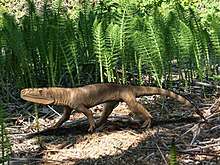 | |
| Home era | Early Triassic |
| Appears in | Extinction Event |
| Number | At least four |
In Extinction Event, a small anomaly opens in a service station along a dual carriageway, and lets through several Euparkeria, which are described as small quadrupedal animals that run on their hind legs when frightened. Because the anomaly site is closed off for the chapter involving the Archosaurs, no members of the public are attacked, but Abby is bitten through a gauntlet by one. The Euparkeria are all rounded up and released through the anomaly before it closes.
Eustreptospondylus
| Eustreptospondylus | |
|---|---|
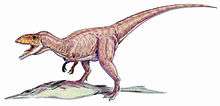 | |
| Home era | Late Jurassic |
| Appears in | Fire and Water |
| Humans killed | 3+ |
Eustreptospondylus was the largest carnivorous dinosaur in Europe during the Jurassic Period, 150-145 mya. The ARC team encounters one that has come through an anomaly into a South African safari park. It is brought into thei park, and is first seen disembowelling a rancher. Later, while attacking Danny Quinn, James Lester and Sophie, who were investigating the disappearances, a pride of lions distract and injure it. The creature escapes, followed by the lions; two of whom will be killed. It is then identified by Connor Temple, who was dealing with Velociraptors and giant crocodilians, and observed attacking hippos; it bites one but the hippo does not sustain much damage. The Eustreptospondylus then attacks the team once more, but a Postosuchus interferes and battles the dinosaur, killing it. The remains of the theropod are found later.
F
Future Beetle
| Future Beetle | |
|---|---|
| Home era | Future |
| First appearance (Primeval) | Episode 5.4 |
| Humans killed | 1 |
| Returned to era? | No. All killed. |
A species of carnivorous beetle from the future resembling the scarab beetle, that move around in enormous swarms led by a huge Queen. Their mandibles are so strong they can chew through concrete.
They appear via an anomaly opened by Connor, kill a guard and cause chaos throughout the ARC going through the vents and piping. Becker shot some of the swarm with an EMD, including the Queen, and others were killed with pesticide. Their venom is not extremely poisonous, but one beetle bit Jess, who went into anaphylaxis. Matt and Connor rigged the anomaly creator to explode in a gamma ray burst to kill the remaining beetles.
Future Bird
| Future Bird | |
|---|---|
| Home era | Future |
| Appears in | Shadow of the Jaguar |
| Humans killed | 1 (kills more with its control) |
| Returned to era? | No. Escapes into Plio-Pleistocene. |
In Shadow of the Jaguar, a creature from the future, theorised to be a future evolution of predatory birds by Cutter, is found controlling a pack of Thylacosmilus with pheromones. It has a certain resemblance to the Incan god, Pacha Kamaq. The team track it down to its lair in the ruins of an Incan temple in the Peruvian jungle. After they disrupt its control over the Thylacosmilus, the creature retreats through the anomaly with them seconds before it closes. Cutter later theorises to Lester the creature may have been seen later in history by the Incas and incorporated into their mythology. The creature had several unusual abilities, such as the ability to control other creatures through the use of pheromones (like a queen bee controls a beehive), and a tongue with a tip covered in many tiny teeth that can burrow into flesh.
Future Fungus
| Fungus Creature | |
|---|---|
| Home era | Future |
| First appearance (Primeval) | Episode 3.5 |
| Humans killed | 4 (all infected, one fell through anomaly, two transformed and one was quarantined) |
| Returned to era? | No. Killed by freezing the ARC hub. |
The fungus is parasitic, extremely aggressive and eats through the flesh of anything that touches it. As soon as someone touches it, it instantly begins converting them into a shell that is loosely human shaped, but has lost all human features and intelligence, relying on instinct. In other words, the fungus effectively kills the host once it has transformed. The ARC team thought that heating the creatures would kill them, but it only advanced their reproduction. In the end, freezing them was the solution. The fungus creature's life cycle is as follows:
- Spores are inhaled into the host's lungs.
- The spores become moist and convert into fungus
- Once consumed the fungus shell turns into a fungus creature which spread the fungus by touch.
- The fungus creature finally roots itself into the ground and waits to spread spores to new hosts.
The fungus is probably the evolved form of the contemporary Cordyceps fungus of south-east Asia for its lifecycle bears a strong resemblance to the fungus. Cordyceps grows inside a host (usually an ant), replacing the surrounding tissue with its own, avoiding the vital organs. It then alters the host's behaviour to make it go to an area of suitable conditions. Cordyceps then grows throughout the host's body, killing it, before becoming completely rooted in the ground or stem the host found itself on. Cordyceps then sporulates, infecting more hosts, by either inhaling the spores through the windpipe or spores falling through pores in the exoskleteton or skin. The Cordyceps fungus probably evolved into the future fungus to attack bigger prey, such as the Megopteran.
The fungus was found by Sir Richard Bentley's assistant after he went through an anomaly in a flat, and accidentally transferred it to the present where Bentley was infected by it. As he slowly took over him, a sample of Connor's at the ARC affected another man, and more quickly turned him into a Fungus Creature. Connor and Sarah's belief that overheating it would kill it was thought to have worked only to learn it actually spread the spores even more, leading the flamethrower-wielding team to capture it instead. After freezing the fungus instead, they found it worked and prepared the ARC to freeze their captured creature, only for it to escape and attack Jenny before it succumbed to the cold.
Future Predator
| Future Predator | |
|---|---|
| Home era | Future |
| First appearance (Primeval) | Episode 1.6 |
| Last appearance (Primeval) | Episode 5.6 |
| Humans killed | 25+ |
Vicious creatures referred to as "Future Predators" are Primeval's most recurring creatures, besides Rex. They are descendants of bats, and like bats use echolocation to hunt and locate prey, with the ears having moved to the front of the face. They are extremely agile, but this comes at a cost, as they are easily stunned by powerful blows. The Future Predators are known to have caused the most deaths out of any creature in the series, both on-screen deaths, and total (if what Helen Cutter said about them wiping out humanity in the future was true). TV critic Walt Belcher of the Tampa Tribune described the Future Predator as "an apelike and skull-headed thing that sort of represents the ultimate dumbing down of the human race"[7]
Their first appearance is in episode 1.6. A mating pair lived in the Permian era after going through an anomaly, and Helen realised they were from the future. When an anomaly led to the present they went through, and proceeded to kill a lion and four innocent people, including Abby Maitland's boss. Helen, believing there was only one, warned the team about it, and they failed in their attempt to kill it initially. Connor Temple came up with an idea to track its echolocation, but was attacked in a car before he was saved by Abby and Stephen Hart. Nick Cutter led the team to its lair, where they discovered it had given birth to five infants before they were attacked by the male. Nick managed to kill him, and he and Helen planned to use the infants to locate the future anomaly in the Permian to try prevent more from going through into that era. However the female Future Predator followed and attacked them, killing Tom Ryan and his men before a Gorgonopsid arrived and knocked her down. Three of the infants were killed before the mother fought back, and though she managed to inflict heavy wounds on the Gorgonopsid she was crushed and killed. Nick and Helen unknowingly left the remaining two infants in the Permian, which changed the future for Cutter & Helen, eliminating Claudia Brown from the history of everyone who hadn't gone through the anomaly.
In episode 2.6, Oliver Leek had control of a Future Predator using a "neural clamp", which he had taken to the ARC and kill some of the staff discreetly before going after James Lester. Lester made several attempts to fight back, turning on Connor's iPod speakers on loud and using a machinegun from the armoury before being cornered in the main room. Leek had the Future Predator leap to deliver the final blow, only for it to become impaled on the tusk of a Columbian Mammoth that Lester had just let loose. In episode 2.7 it is revealed Leek has successfully captured a pack of Future Predators, and using neural clamps to maintain control over them, referring to them as his "Praetorian Guard". Cutter was pursued by one through the facility until he managed to draw it in close with his blood before ripping the neural clamp from its head, killing it. Leek threatened to use the rest of his controlled Future Predators to tear Cutter apart, however Cutter freed them of their mind control devices by forcing the one he had into a fuse box, disabling the rest. They then turned on Leek and killed him before they were locked in a feeding chamber along with all of the other creatures that Leek, Helen and their soldiers had locked kept. They were among the creatures that killed Stephen as he sacrificed himself to keep the creatures locked up to have them kill one another.
In episode 3.1, Future Predators appear in their own environment in an old city. They were the inadvertent guards for a mysterious artefact. Soldiers sent by Christine Johnson to recover the artefact killed a young Future Predator before an adult kills all but one of the soldiers. In episode 3.4, Christine was shown to have been operating on one in an attempt to learn how to recreate its echolocation. It woke up, and Christine had it killed. In episode 3.8, a pack of Future Predators stalked the team when they arrived in the future. Captain Becker killed one while accidentally alerting several others to their presence due to the noise from his gun. An infant leaped out of a car to attack Danny Quinn, scarring his neck before he stomped on it. More approached as the team were rescuing Jack Maitland, and Becker led them away. The team were trapped in an abandoned bus by the Future Predators before several Megopterans arrived and the two species fought amongst themselves, and the still alive Becker killed another as it came towards the team. In episode 3.9, a Future Predator kills Christine after she was pushed through an anomaly leading to the future by Helen. In episode 3.10 one stalked Danny, Connor and Abby as they searched for Helen, but was locked away from them. It soon broke into the room along with several others, narrowly missing their quarry as they escaped into the Cretaceous through an anomaly which was closed to prevent them following.
In episode 5.6, the Future Predators are shown differently, having evolved to survive in the harsh landscape caused by Philip Burton. They are much quicker than before, have more sun-damaged skin, and with food so scarce they attack each other to claim prey for themselves. One prepared to attack Connor before a storm came up, and it fought with another before the victor was brought down by Abby. A group attacked as Connor, Abby and Matt Anderson made their way back to the anomaly, though they fought amongst themselves. A pair went through an anomaly created by Connor into the ARC, and attacked Lester and Jess Parker. They severely injured Lester, and when the team arrived Abby came up with a plan to paralyse them by using ultra-sonic noise. The first had Abby pinned before Becker killed it with his EMD, and the other froze as Abby initiated her plan, and Becker was able to use his EMD to kill it with only a few close range blows.
The "Future Predators" also appear on the Watch YouTube Game. They attack your computer screen and it takes three hits to kill them.
Future Shark
| Future Shark | |
|---|---|
| Home era | Future |
| First appearance (Primeval) | Episode 2.4 |
| Number | 1 |
| Returned to era? | No. Killed by the team. |
The Future Shark is the future evolution of a modern-day shark. It looks similar to some deep-sea sharks, but has a special adaptation: a very long tongue armed with spikes that can be fired from the jaw like a harpoon. Modern day sharks such as the tiger shark have been found with litter in their stomachs, including plastic bags, tins and car registration plates: the basketball and the shoe found in the Future Shark's stomach could be a reference to this.
In episode 2.4 this creature prepared to attack Jenny Lewis in the water before it was shot by Stephen Hart and then captured by the team who suspected it of killing a boy. After examining the creature in their ARC, Nick Cutter concluded it was probably the descendant of the shark. Since no remains of the boy were found in the creature's stomach, and sharks typically take days to digest their prey, it did not kill the missing boy.
Future Worm
| Future Worm | |
|---|---|
| Home era | Future |
| First appearance (Primeval) | Episode 3.8 |
| Number | 1 |
A future worm attacks Jack Maitland in the underground in the future. They are similar to the worms from episode 2.2 in that they shoot a foul liquid at their prey, but they more resemble maggots in appearance. It is not clear if the worms are larvae of the Megopteran or if they are a completely different species. They probably are not the larvae of the Megopteran as its young were seen in the present not long after they came out of a dead human body and are miniature versions of the adult animal.
G
Giant spider
| Giant spider | |
|---|---|
| Home era | Carboniferous |
| First appearance (Primeval) | Episode 1.2 |
| Humans killed | 1 |
| Returned to era? | Yes |
The giant spiders are, despite appearances, not true spiders (order Araneae), but a species of Solifugae, a distinct arachnid order. The name derives from Latin, and means those that flee from the sun. The adults are up to 1 m (39 in) wide, by 1 m long, because the lush rainforest of the Carboniferous saturates the atmosphere with oxygen, allowing them to grow larger than modern arthropods. They have pincers instead of fangs – like the modern day camel spider, only much bigger. They also have long pedipalps, which function as sense organs similar to insects' antennae and give the appearance of the two extra legs. Pedipalps terminate in reversible adhesive organs. They do not appear to make webs or produce venom but they nest in large groups and are very defensive of their offspring.[4]
A nest of them appears in the second episode. Ryan and the other special forces enter the tunnel, and they are attacked by a whole group of them, killing one of the soldiers. They find out that the spiders did not kill the pest controller, because the bite looked different. It would be found out that they avoid light, and by using torches, all the giant spiders are driven back through the anomaly by the end of episode 1.2.[4]
These creatures are based on fragmentary fossils which scientists thought was a 1 m wide spider but this has just recently been reclassified as a type of scorpion.[3] The giant spiders also featured in the advertising campaign for the show, first on giant billboards on 1 February 2007 and again in The London Paper on 16 February 2007.
Giganotosaurus
| Giganotosaurus | |
|---|---|
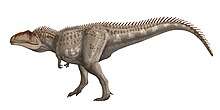 | |
| Home era | Early Cretaceous |
| First appearance (Primeval) | Episode 3.4 |
| Humans killed | 4 |
| Returned to era? | Yes |
Giganotosaurus is one of the largest species of carnivorous dinosaurs. It is shown to be able to run at high speed for a surprisingly long distance, considering its huge size and weight. It is dubbed a "G-Rex" by the characters throughout the episode because it is pictured just like a T-Rex just slightly bigger.
In episode 3.4, one appears at an airport and starts attacking a news crew investigating the anomaly. It ate Nigel Marven, then went back through before it returned and ran out onto the runway, attacking an aeroplane. Connor Temple lured it away with a luggage carrier before it tripped over the small vehicle and pinned Connor down on the runway. Then a helicopter piloted by Danny Quinn lured it back through the anomaly. Danny came back in time to reveal that there was a large pack on the other side of the anomaly, and Connor only just manages to lock the anomaly in time.
Gorgonopsid
| Gorgonopsid | |
|---|---|
 | |
| Species | Gorgonops, Lycaenops |
| Home era | Permian |
| First appearance (Primeval) | Episode 1.1 |
| Last appearance (Primeval) | Episode 1.6 |
| First appearance (Primeval: New World) | "Undone" |
| Number | 4; 2 Gorgonops, 2 Lycaenops |
| Humans killed | 1 in Primeval, 2 in Primeval: New World |
| Returned to era? | Episode 1.1 – killed Episode 1.6 – already in its own time "Undone" – both killed in present. |
Gorgonopsia are a group of creatures that were at one time called "mammal-like reptiles", though in most current classification systems, they are not classed as reptiles as they are more closely related to mammals. Their mammalian specialisations include differentiated tooth shape, the fully developed temporal fenestra, pillar-like rear legs as well as other traits associated with its mammalian descendants. Arguments have even been made for synapsids of its time being endothermic.
What's really special about Gorgonopsids is their patience and implacability. Once they have smelt blood they have a tendency to pursue their prey at all costs. In fact it was this keen sense of smell that originally tempted it into the cold present, lured by the smell of humans and waste from a supermarket.[3] They then store their kills in trees like leopards.
A Gorgonopsid was first seen chasing Helen through a car parking lot after travelling to the present through an Anomaly in the Forest of Dean, and chased her through the Anomaly in question. Eight years later, the same Anomaly re-opened and a Gorgonopsid came through once again; it was eventually shot and killed by Stephen.[8] In a later episode, after Nick and Helen went through the same Anomaly after it re-opened and were attacked by a Future Predator that had followed them, a Gorgonopsid showed up and, after killing and devouring most of the Predator's babies, had a brutal fight with the adult Predator, emerging victorious after crushing it to death.[9]
This new species is a typical representative of the Gorgonopsia, It is distinguished from other species by a longer snout, and other details of the bones of the skull. It also has naked skin with short bristly hair rather than scales. This creature is based on Gorgonops longifrons found in the Karoo Basin in South Africa which was between 3 and 4 m (10 and 13 ft) long and had 8 cm (3 in) sabreteeth.[3]
Gorgonopsid also returned in the episode "Undone" of Primeval: New World. The species that appears is Lycaenops. The Cross Photonics predator control team captures a female who is stalking students at a college library. Mac is sprayed by the female, and while the team chase after the male that followed the female on campus, the female kills Mac's girlfriend, Sam. Mac then hunts out of vengeance the female and kills her and then later her mate.
H
Hesperornis
| Hesperornis | |
|---|---|
 | |
| Species | Hesperornis |
| Home era | Late Cretaceous |
| First appearance (Primeval) | Episode 1.3 |
| Number | 1 |
| Humans killed | 1 |
| Returned to era? | Yes |
Hesperornis is an extinct genus of flightless aquatic birds that lived during the Late Cretaceous. Hesperornis were fairly large birds, reaching up to 1.5 m (4.9 ft) in length. They had virtually no wings, swimming with powerful hind legs. Their toes were probably lobed rather than being webbed, as in today's grebes; like in these, the toes could rotate well, which is necessary to decrease drag in lobed feet but not in webbed ones such as in loons, where the toes are simply folded together. Like many other Mesozoic birds such as Ichthyornis, Hesperornis had teeth in its beak which were used to hold prey (most likely fish). In the hesperornithiform lineage they were of a different arrangement than in any other known bird (or in non-avian theropod dinosaurs), with the teeth sitting in a longitudinal groove rather than in individual sockets.
They hunted in the waters of the North American Inland Sea which then were tropical waters, much warmer than today. They probably fed mainly on fish, their teeth were helpful in dealing with slippery or hard-shelled prey. Later as Nick Cutter swims through the anomaly he finds himself in a tropical sea with a flock of Hesperornis swimming around him. He later finds a Hesperornis rookery amongst the rocky shoreline. Two Hesperornis investigate, but Helen Cutter shoos them off by throwing small stones, and says that they "tend to be more dumb than violent, only attacking when they're in a panic or disturbed."[10]
Hesperornis is shown as being covered in scales when in real life, Hesperornis was likely covered in feathers. Also they were not able to stand upright or walk as the legs attached far at the back and sideways, with even the lower leg being tightly attached to the body. Thus, they were limited to sliding on their belly or galumphing.
Hyaenodon
| Hyaenodon | |
|---|---|
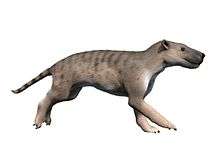 | |
| Species | Hyaenodon |
| Home era | Early Miocene |
| First appearance (Primeval) | Episode 4.6 |
| Number | 6 (3 cubs, 3 adults) |
| Humans killed | 1 |
| Returned to era? | 5 returned, one adult fell to its death |
Hyaenodon is an extinct genus of Hyaenodonts, a group of carnivorous creodonts of the family Hyaenodontidae. Some species of this genus were amongst the largest terrestrial carnivorous mammals of their time, others were only of the size of a marten. They had very massive skulls but only small brains. It had a long skull with a narrow snout – much larger in relation to the length of the skull than in canine carnivores, for instance. Its neck was shorter than its skull, while its body was long and robust and terminated in a long tail. Despite the name, these creatures are not related to hyenas.
A total of two adults and three cub Hyaenodons came through an anomaly in the wine cellar of a stately mansion, where Jenny Lewis is getting married, in episode 4.6, making a den. An adult killed a wedding planner in the cellar where the pups were. Connor stunned one male Hyaenodon and it was sent back through the anomaly. He was trapped in the cellar because of the female, and gave some wine to two cubs to knock them out and returned them to the anomaly before trying to get the third through as well, only to allow the male back through. The two adults attacked the wedding party and were fought off with medieval weapons. All the Hyaenodons were returned.
I
Iguanodon
| Iguanodon | |
|---|---|
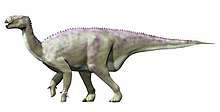 | |
| Home era | Cretaceous |
| Appears in | The Lost Island |
| Number | Well over 100 in the Cretaceous, one in modern world |
The Iguanodon is first encountered in The Lost Island as a juvenile, which has fallen down a hill and broken its leg. Cutter shoots it to put it out of its misery. Later, when marooned in the past, the team witness hundreds of Iguanodon moving on a plain below, being attacked by Neovenator and associating with Polacanthus. Matt Anderson mentions handling a herd of them that had found their way into a beauty pageant during his first mission as team leader at the end of Series 4 webisode 5.
J
Jurassic beetle
| Jurassic beetle | |
|---|---|
| Home era | Jurassic |
| First appearance (Primeval: New World) | Fear of Flying |
| Humans killed | 2 |
| Returned to era? | Yes |
Jurassic beetles are a species of arthropod from the Jurassic. They are carnivorous, eusocial creatures that use live animals as incubators for their eggs. Jurassic beetles are black or grey beetles, and are carnivorous. Workers and drones are approximately the same size as modern day beetles, while queens are around eight feet in length, with extremely hard and armoured carapaces and large wings which allow them flight. The beetles have very small, almost invisible eyes, due to which they have poor eyesight and avoid fire and bright light, and for that fact they have long antennae to compensate.
It is known that drone and worker Jurassic beetles generally attack prey in massive swarms to overwhelm and devour it in seconds. It is also known that a queen beetle breeds by capturing a live victim and depositing at least one sac of gelatinous eggs from its mouth down into the captured host's throat.
The Jurassic beetle drones are similar to the future beetles, and the queen Jurassic beetle is similar to the Megopteran and the more over the queen future beetle.
K
Kaprosuchus
| Kaprosuchus | |
|---|---|
 | |
| Home era | Early Cretaceous |
| First appearance (Primeval) | Episode 4.2 |
| Last appearance (Primeval) | Episode 5.5 |
| Number | 1 |
| Humans killed | 3 (one ARC soldier due to a backfiring EMD shot.) |
| Returned to era? | Episode 4.2 – No, killed by team Episode 5.5 – Unknown |
Kaprosuchus is known by only a single skull, discovered by the palaeontologist Paul Sereno in 2009. The prehistoric crocodile had oversized tusks embedded toward the front of its upper and lower jaws, inspiring Sereno's affectionate nickname, the BoarCroc. Like many crocodiles of the Cretaceous period, Kaprosuchus was not restricted to river ecosystems; judged by its long legs and impressive dentition, this four-legged reptile roamed the plains of Africa much in the style of a big cat. In fact, with its big tusks, powerful jaws and 6.1-metre (20 ft) span, Kaprosuchus may have been capable of taking down comparably sized herbivorous (or even carnivorous) dinosaurs.
A Kaprosuchus appeared in episode 4.2, having grown from a hatchling flushed into the sewer 5 years previously into an adult preying on the homeless living by the Thames. Its presence was discovered by Connor, Abby and Duncan, who alerted the ARC with Matt after he saved them from its initial attack when its home was set on fire by construction workers. Though it was brought down by an EMD and contained, it woke up and escaped, chasing Duncan into a maze of containers, killing a soldier. After forcing it out of a maze of containers, the team inadvertently killed it with EMDs since the firepower was too much for it.
Another appears in Episode 5.5, coming through a new anomaly during the anomaly convergence, and attacking Connor and Philip's car. Philip left Connor on his own, and Connor called Abby for help, who arrived and brought it down with an EMD while driving. Whether or not it survived and was returned, or whether it was killed is unknown.
The Kaprosuchus also appears on the Watch YouTube Game. It would take two hits to kill the Kaprosuchus.
L
Labyrinthodont
| Labyrinthodont | |
|---|---|
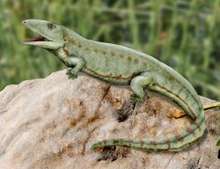 | |
| Home era | Late Paleozoic / Early Mesozoic |
| First appearance (Primeval) | Episode 4.5 |
| Number | 2 (one young and one adult) |
| Humans killed | 3 |
| Returned to era? | Yes |
Labyrinthodonts were generally amphibian-like in build. They were short-legged and mostly large headed, with moderately short to long tails. Many groups, and all the early forms, were large animals. Primitive members of all labyrinthodont groups were probably true water predators, and various degrees of amphibious, semi-aquatic and semi terrestrial modes of living arose independently in different groups. Some lineages remained or became secondarily fully aquatic with reduced limbs and elongated, eel-like bodies.
A large labyrinthodont with a very long tail, and a juvenile, appeared in a seaside cave in episode 4.5.[11] The adult had been causing many people and animal stock to go missing over the ten years since the anomaly had previously been open. It killed someone camping out to investigate the 'Witchfield Worm', and Matt Anderson saved a fisherman from been devoured too. Abby Maitland pursued the creature to a campsite where she lured it on top of a caravan and drove it part way to the anomaly site. Connor Temple discovered the infant in the cave, and its cries of pain caused by acid drew the adult back. It killed two people, one of whom had known about the creature and attempted to contain it, before being driven back through the anomaly by Connor and Abby.
Larvae
See Future Worm
Liopleurodon
| Liopleurodon | |
|---|---|
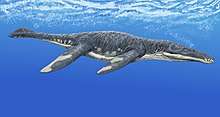 | |
| Home era | Late Jurassic |
| First appearance (Primeval) | The Lost Island |
| Last appearance (Primeval) | Episode 5.2 |
| Number | 3 |
| Returned to era? | Yes (in episode 5.2) |
Liopleurodon are a species of Pliosaur, an extinct type of marine reptile.
In The Lost Island novel, a Liopleurodon sinks a trawler boat in the Atlantic south of Ireland, at Guns Island, and is later encountered by the team in the water. It seems heavily resistant to bullets, but when the team discover it, it is dying from the cold of the Atlantic winter.
In episode 5.2 a Liopleurodon comes through an anomaly in the North Sea, and attacks and disables a naval submarine. The submarine is drawn through the anomaly to the Jurassic and the Liopleurodon follows it back. A pod of them swim around the submarine, banging it to see if it is food. When a swimming theropod is ejected from the vessel, all of the creatures go after the decoy, and one of the Liopleurodons eats it.
M
Meganeura
| Meganeura | |
|---|---|
| Home era | Carboniferous |
Meganeura is a genus of extinct insects from the Carboniferous period approximately 300 million years ago, which resembled and are related to the present-day dragonflies. With wingspans of more than 75 cm (2.5 ft), M. monyi is one of the largest known flying insect species; the Permian Meganeuropsis permiana is another. Meganeura were predatory, and fed on other insects, and even small amphibians.
Megopteran
| Megopteran | |
|---|---|
| Home era | Future |
| First appearance (Primeval) | Episode 3.8 |
| Last appearance (Primeval) | Episode 3.10 |
| Humans killed | at least 5 (also a factor of the apocalypse) |
| Returned to era? | yes, but three killed in the present |
ITV launched a competition for a viewer to design a creature, which was judged by the creators and will appear in Series 3. The winner was 16-year-old Carim Nahaboo from Essex,[12] whose creature is a large predatory insect from the future which, as Carim described, "evolved from carnivorous beetles, such as the tiger beetle".[13] However, the series described it as evolving from either wasps or ants. The creature can fly and run fast over long distances, and lives in future jungles.[13] It is known as Megopteran.
In episode 3.8 a group of them are gassed out by Danny and become the team's distraction when they are surrounded in a bus by Future Predators – a vicious fight ensures that the team escapes. As they do, a huge Megopteran appears and heads in their direction, but is not seen afterwards. This particularly large Megopteran may have been the dominant queen or leader of the nest. They are shown to have an ovipositor, with which they can lay eggs into a host. Three creatures re-appear in the Series 3 finale and are seen rampaging around in Christine Johnson's base. Two are killed by Becker using electrical wires and the third one is presumably dead.
Mer
| Mer | |
|---|---|
| Home era | Future |
| First appearance (Primeval) | Episode 2.4 |
| Last appearance (Primeval) | Episode 2.7 |
| Humans killed | 1 |
| Returned to era? | Episode 2.4 – Some killed in the present by Stephen and Lucien, others returned to the future and then killed by Connor, Nick and Stephen Episode 2.7 – Killed in fight |
The Mer first appear in episode 2.4. They are aquatic predators from the future, using the sewer network to hunt and trap prey. They successfully capture a teenage boy called Lucien Hope, and then Abby, before dragging Abby into their time zone. After being rescued by Nick and Connor, Lucien kills one of the Mer by throwing a stone at its head, before Stephen shows up and shoots the rest, killing them too. Meanwhile, Connor travels through the Anomaly into the future to find Abby and throws a stone at the head of a Mer threatening her, killing it, before attempting to pull her up onto the cliff ledge he is standing on to help her escape the Mer Queen. Nick arrives in time to help him pull Abby to safety, and then he and Stephen shoot and kill the Mer Queen and the rest of the attacking Mer Creatures. Nick later speculates that the Mer may be descendants of humans.
There appear to be two types of Mer;
- The Mer Queen who is red in colour, and much larger than her subordinates. She has tusks on her lower jaw, whereas the others do not. When Abby attempts to escape from the future, the Mer Queen reacts violently, to the point that she crushes any other Mer in her path.
- The remaining Mer are blueish in colour, and work at capturing food. They do not immediately kill their prey, instead dragging it back to their home, where presumably it is later consumed.
In episode 2.6 and 2.7, it is revealed Oliver has managed to acquire two Mers for his collection. The creatures would escape from the feeding chamber, and attempts to break down a door to leave the bunker, before returning to the feeding room in an attempt by Nick, Stephen and Helen to trap the creatures there, so that they kill each other.
Mesosaurus
| Mesosaurus | |
|---|---|
 | |
| Home era | Permian |
| First appearance (Primeval) | Episode 1.1 |
| Number | 1 |
| Returned to era? | Yes |
Mesosaurus (meaning "middle lizard") is an extinct genus of reptile from the Early Permian of southern Africa and South America. Mesosaurus was one of the first reptiles to return to the water after early tetrapods came to land in the Late Devonian or later in the Paleozoic. It was around 1 m (3.3 ft) in length, with webbed feet, a streamlined body, and a long tail that may have supported a fin. It probably propelled itself through the water with its long hind legs and flexible tail. Its body was also flexible and could easily move sideways, but it had heavily thickened ribs, which would have prevented it from twisting its body. A picture of Mesosaurus is on the wall of Nick Cutter's lab at the Central Metropolitan University as Stephen walks into the lab.
Unknown millipede
| Home era | Silurian |
|---|---|
| First appearance (Primeval) | Episode 2.5 |
| Number | 1 |
| Returned to era? | Yes |
The Silurian is shown as being home to not only Silurian scorpions, but also millipedes which roam in groups across the sand. They prefer to hide in the sand but may emerge if frightened by a predator. These millipedes are likely to be the staple food source for the giant scorpions.
In episode 2.5, Nick Cutter and Stephen Hart noticed a large group of them travelling on the sand, which they failed to realise were fleeing from the scorpions. One entered the present era briefly but was captured by Abby in a ball pool before it was returned into the past.
Mosasaur
| Mosasaur | |
|---|---|
 | |
| Species | Mosasaurus |
| Home era | Late Cretaceous |
| First appearance (Primeval) | Episode 1.3 |
| Number | 2 |
| Humans killed | 1 |
| Returned to era? | Yes, but killed in its own era |
Mosasaurs were serpentine marine reptiles and ferocious predators. Mosasaurs were not dinosaurs but evolved from semi-aquatic squamates known as the aigialosaurs, close relatives of modern-day monitor lizards. Mosasaurs breathed air and were powerful swimmers that were well-adapted to living in the warm, shallow epicontinental seas prevalent during the Late Cretaceous Period. Mosasaurs are intensely territorial and cannibals, and the only meetings between them that do not end in violence occur when the Mosasaurs in question are of opposite sexes, and there is the possibility of mating.[10]
The skull was more robustly built than other Mosasaurs, as the mandibles articulated very tightly with the skull. It had a deep, barrel-shaped body, and with its fairly large eyes, poor binocular vision, and poorly developed olfactory bulbs, experts believe that Mosasaurs lived near the ocean surface, where it preyed on fish, turtles, ammonites as well as smaller Mosasaurs. Because of its robust skull and tightly articulating jaws, mosasaurs was unable to swallow prey-items whole in the manner of earlier mosasaurs, such as Tylosaurus. Instead, with the aid of its curved, knife-like teeth, mosasaurs was able to tear its prey into more manageable pieces that could be more easily swallowed.
The Mosasaur was shown to have an armoured crocodile-like body, but in reality it would have been smooth-skinned and streamlined, and covered in more lizard- or snake-like scales. Also it swallowed the lifeguard whole even though its jaw and enlarged neck muscles were evolved to tear and rip prey apart. The Mosasaur depicted also has a more tapering, snake-like body than its real life counterpart, and a pair of short horns over the head, like a theropod dinosaur.
N
Neovenator
| Neovenator | |
|---|---|
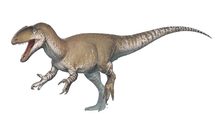 | |
| Home era | Early Cretaceous |
| Appears in | The Lost Island |
| Number | 3; none came through anomaly |
In the Primeval spin-off novel The Lost Island, the team witness a pack of three Neovenator attack a herd of Iguanodon, but it is not known if the hunt is successful. Cutter initially mistakes them for Allosaurids but their presence nonetheless gives Cutter reason to move the team from their hunting grounds.
O
Ornitholestes
| Ornitholestes | |
|---|---|
 | |
| Home era | Late Jurassic |
| First appearance (Primeval: New World) | Babes in the Woods |
| Last appearance (Primeval: New World) | The Inquisition |
| Number | 3 |
| Returned to era? | 2 returned, 1 captured. |
Ornitholestes is a species of theropod dinosaur that lived during the Jurassic, 150 million years ago. Ornitholestes are stalkers; they track their prey by stalking it through the woods, and will usually attack the smaller members of groups of prey. Ornitholestes are also highly aggressive, and can be easily provoked into attacking other creatures. They can also be quickly brought down by shooting them directly in the neck with an electric dart, but shooting them in the side or below the neck has little effect.
At least one Ornitholestes was taken by Project Magnet from the Mount Seymour Anomaly incursion, and sent to a research laboratory in Vancouver, where it was subjected to gruesome experiments from which it apparently at some point died.
P
Pachycephalosaurus
| Pachycephalosaurus | |
|---|---|
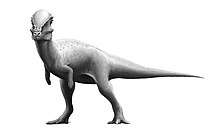 | |
| Home era | Late Cretaceous |
| Appears in | Extinction Event |
| First appearance (Primeval: New World) | "Truth" |
| Number | 2 |
| Returned to era? | No |
In the past Jenny, Helen Cutter and the men supporting the British team observe a Tyrannosaurus hunting and killing a Pachycephalosaurus, which is described as having a knobbed head and using the domed forehead for display rather than head-butting, according to Helen.
In Primeval New World, a Pachycephalosaurus went on a rampage smashing windows mistaking its own reflection to be a rival. It was taken down by the team, but sneezed on Evan before it became unconscious. The Creature was secretly taken by Ken Leeds to the Project Magnet facility, where it was experimented on and died at some point.
Parasite
| Parasite | |
|---|---|
| Home era | Holocene |
| First appearance (Primeval) | Episode 1.4 |
| Number | 2 |
| Humans killed | 1, although another was infected and presumably cured. |
| Returned to era? | No. Died due to lack of oxygen in bell jar. |
This previously undiscovered species is a cestoid[14] Parasite, up to 30 cm (12 in) long and weighing up to 70 g (2 oz) from the late Holocene. The Parasites belong to the group Taeniidae. which are distinguished from the other families of the order Cestoidea by having a distinct head, furnished with four suctorial discs.[6] They did not come to the present directly, but instead were carried through by 2 dodos that were their hosts at that point.
They feed off the nutrients in the bloodstream of its host, destroying the internal organs in the process. It then burrows into the brain of the carrier and manipulates it for the benefit of the Parasite. The Parasite causes the host to become aggressive and photophobic. The bite of the host serves to spread the Parasite's eggs, which are released into the saliva, to a new host.[6] It is hinted that the parasites could be responsible for the vampire myth.
The mature Parasites would kill the host and themselves as part of their reproductive cycle. Each individual has male and female reproductive structures in its proglottid and can reproduce independently. Any warm-blooded creature is an acceptable host, even humans.
Postosuchus
| Postosuchus | |
|---|---|
 | |
| Home era | Late Triassic |
| Appears in | Fire and Water |
| Number | 2 |
| Humans killed | 6 |
| Returned to era? | No |
Postosuchus was a land living crocodilian that lived in North America and was the top predator in its ecosystem. A Postosuchus seemingly comes through an anomaly to a South African Safari Park and kills a Eustreptospondylus (however, it is later revealed that both creatures were captured and transported the park by Tom Samuels' people). It later kills several zebra and wildebeest. The creature is later lured by an impala and attacks the team before Sophie sacrifices her life to save Danny. The creature is killed when it is shot in its stomach. Several postosuchus are used for patrolling Samuels' oil refinery as "guard dogs" and are controlled with an electric shock collar. A postosuchus later kills park worker Ted as well as Samuels. A family of Postosuchus are later seen attempting to escape from their cage. It is unknown if the family survive the oil refinery's destruction although the cage may have protected them. Like the Gorgonopsid, they had tremendous power; therefore they would have caused havoc between herds of creatures in their own time.
Postosuchus is portrayed being a quadrupedal animal in the show, however recent scientific finds revealed that the animal was bipedal.
Phorusrhacid
| Phorusrhacos | |
|---|---|
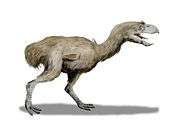 | |
| Species | Phorusrhacos |
| Home era | Plio-Pleistocene |
| First appearance (Primeval) | Episode 3.6 |
| First appearance (Primeval: New World) | "The Great Escape" |
| Humans killed | 8+ |
| Returned to era? | Episode 3.6 – Yes, (1 killed by a mine, 1 beheaded by car shrapnel) Episode 4.7 – Presumably Angry Birds – 2 returned, 1 captured The Great Escape – No, killed by Dylan |
Phorusrhacids or "terror birds" are large carnivorous flightless birds that were the dominant predators in South America shortly during the Cenozoic period, 62-2.5 million years ago. They were roughly 1–3 m (3–10 ft) tall. Titanis walleri, one of the largest species, is known from North America, marking one of the comparatively rare examples where animals that evolved in South America managed to spread north after the Isthmus of Panama land bridge formed. Their wings evolved into meat hook-like structures that likely could be outstretched like arms to perform a hacking motion to help bring down prey. Like the armour-plated ostriches they resemble, terror birds are also very fast runners.
They first appear in episode 3.6. They first came through the anomaly in the 1950s, and attacked and killed scientists that were studying the anomaly. When the anomaly reopened in the present day, they came through again, and one was drawn to a cabin the team were hiding it due to a recording of a distress call of the birds they had accidentally played. It chased the team in their car, and Danny Quinn fought it off with a pipe before they crashed. Abby Maitland and Sarah Page fled while Danny used Connor Temple as bait to draw in the bird, trapping it by hooking its leg into the car's tow cable. Abby and Sarah were chased by several more and chased to a minefield along with Danny and Connor, and Danny lured one onto a mine, killing it. Another attacked and killed one of Captain Ross's soldiers and was killed as the car exploded on a mine and the shrapnel cut through the bird's neck. The rest of the flock attacked the cabin, and Connor distracted them so that Danny could play the distress call recording to lure them back to the anomaly.
A single terror bird attacked in a prison in episode 4.7, coming through a "satellite anomaly" and killing a tourist. It returned through the main anomaly and was driven back by the team, however it appeared through another satellite anomaly Abby and Becker found. It was allowed to go through the main anomaly, but it returned again to distract the team as they were attempting to capture Ethan Dobrowski. Connor and Abby chased after it, and Danny arrived to help knock it through a satellite anomaly. Again the terror bird returned, this time being brought down by Matt Anderson's EMD. Abby contained it in a storage closet, but it was set free by Ethan/Patrick to menace Emily Merchant, but was able to use a club to bring it down again. It was presumably returned to its own time after that.
Pliosaur
| Pliosaur | |
|---|---|
| Home era | Jurassic / Cretaceous |
| First appearance (Primeval) | Episode 5.2 |
| Number | dozen |
Pliosaurs are a large type of marine reptile from the Jurassic and Cretaceous. They may live in pods of three or so, generally not attacking one another. When confronting other large objects in the water, they will react aggressively by ramming and biting. They have been witnessed to rub their bodies along smaller objects to try to get a reaction to see if the object is alive before eating. If the object is moving, however, they take it for food and will devour it immediately.
The Pliosaurs encountered such as Liopleurodon are bullet-resistant, and due to the warmer conditions of the oceans in the Jurassic, if a Pliosaur such as Liopleurodon stays in the colder seas of the present day for too long, it will die from the conditions. They are known to eat Swimming Theropods. Liopleurodon is a type of Pliosaur. A Liopleurodon came through an Anomaly into the present day Atlantic Ocean, where it presumably died from the Ocean's cold conditions.
Polacanthus
| Polacanthus | |
|---|---|
| Home era | Early Cretaceous |
| Appears in | The Lost Island |
| Number | At least a dozen; none come through anomaly |
In the Primeval spin-off novel The Lost Island the team run into a sleeping herd of Polacanthus when marooned in the Cretaceous. Cutter carefully manages to move the team around the group of Ankylosaurs, and later they observe a herd of them associating with Iguanodon.
Pristichampsus
| Pristichampsus | |
|---|---|
| Home era | Palaeocene |
| First appearance (Primeval) | Episode 3.1[15] |
| Humans killed | 2 |
| Returned to era? | Yes |
The Pristichampsus was described by Adrian Hodges and Tim Haines as a "bit souped-up for our show – bigger, more powerful, all that sort of stuff" and "a running crocodile, he's also quite bipedal". It seems to be based on the real fossil crocodilian genus Pristichampsus, of which one species (P. rollinatii) was facultatively bipedal.[16][17] Pristichampsus has a vague similarity to Amut, it is later revealed that the Ancient Egyptians thought that the creature was the god Sobek, because of the similarities that they have, and that the anomaly was a gateway to the land of the gods. The series' creators have also confirmed it will be found in the Thames river and then destroy a kitchen.[15] In the new ITV Winter Spring Showreel, the Primeval trailer briefly shows the Pristichampsus rearing over cars and swimming in the river.
A Pristichampsus came through an anomaly in episode 3.1. It killed the caretaker Marianne but left her body, possibly as a warning to competitors. It attacked Sarah Page but escaped from the museum at its first opportunity through the docking door. It went on to kill a traffic warden and then swam across the Thames to a restaurant, attracted by the scent of hot food. It escaped to the top floor in a lift and attacked a cleaning woman. Cutter saved her by luring it out of a window. The Pristichampsus fell, injuring its leg. It then started to return to the museum and the anomaly, its instinct to survive outweighing its instinct to hunt. Cutter, Becker and an armed escort met the creature there, but taking Sarah and Abby's advice, bowed to show there were not a threat. The Pristichampsus passed them without attacking and climbed through the anomaly just before it closed.
Throughout the episode, several other Pristichampsus almost came through the anomaly. It was revealed in the episode that Pristichampsus was the inspiration for the Egyptian goddess Amut. Cutter used this as an example that some of the anomalies and the creatures that came through them were the inspiration for myths and legends.[18]
Pteranodon
| Pteranodon | |
|---|---|
 | |
| Species | Pteranodon |
| Home era | Late Cretaceous |
| First appearance (Primeval) | Episode 1.5 |
| Last appearance (Primeval) | Episode 3.10 |
| Number | 1 |
| Humans killed | 1 |
| Returned to era? | Yes |
Pteranodon was a large Pterosaur, notable for its skull crest. These may have been used as mating displays, or it might have acted as a rudder, or perhaps both; also, it may have acted as a counterweight to the large beak. Despite its huge size, at 6 m (20 ft) Pteranodon is not the biggest of the pterosaurs; creatures such as Quetzalcoatlus could reach 11 m (36 ft).[3]
It could, like the modern-day albatross, glide by navigating through thermals because the Pteranodon had a high aspect ratio (wingspan to chord length) similar to that of the albatross — 9:1 for Pteranodon, compared to 8:1 for an albatross, but was also fully capable of powered flight.
In episode 1.5, a Pteranodon appears from an anomaly above a golf course, where it apparently attacks Connor and Rex. After some chasing, Connor and Rex jump down a hill as the Pteranodon swoops and flies away above them. It was assumed that this creature was responsible for the death of a golfer earlier. Later Stephen discovers that its diet contains fish and small reptiles but no human remains, proving that it did not kill the golfer and the real killer is still out there. This also proves that it was trying to catch Rex, not kill Connor.[2]
Also, a Pteranadon appears in the opening of episode 2.2 attacking Helen Cutter after she steals one of its eggs, though this was unrelated to the events of the episode.[19]
A Pteranadon appears again in episode 3.10 attacking Helen Cutter as she tries to go through an anomaly and causes her to drop her anomaly device.
Pterosaur
| Pterosaur | |
|---|---|
| Home era | Triassic / Jurassic / Cretaceous |
| First appearance (Primeval) | Episode 1.3 |
| Number | 7 seen in past |
| Returned to era? | Never left own time |
Pterosaurs are (sometimes very large) flying reptiles, that lived in the Upper Triassic to Upper Cretaceous periods. They are not dinosaurs.
In episode 1.3, Nick Cutter travels through an underwater anomaly and finds himself in a Cretaceous tropical sea, 75 million years ago. As he comes ashore and puts his scuba down on the beach he observed several Pterosaurs flying and feeding over the coastal waters.
In The Lost Island an unidentified Pterosaur species are described resting on rocks, and basking in the sun with their wings open like the modern-day cormorant.
R
Raptor
| Raptor | |
|---|---|
 | |
| Species | Deinonychus |
| Home era | Cretaceous |
| First appearance (Primeval) | Episode 2.1 |
| Last appearance (Primeval) | Episode 5.3 |
| Humans killed | 20, and 1 wounded (12 victims were from the Victorian era) |
| Returned to era? | Episode 2.1 – One returned, one cannibalised, another decapitated Episode 2.6 – No Episode 2.7 – Killed in fight Episode 3.4 – ran back through the anomaly Episode 3.10 – 3 in own time 1 died from fall 4.1 – Was already in own era Episode 5.3 – Unknown. |
Raptors are bipedal carnivores with a long, stiffened tail and had an enlarged, sickle-shaped claw on each hindfoot, which is thought to have been used to kill their prey. Males were a lot stronger than the females, as the female in the show needed one indirect dose of tranquilliser to bring her down, while the male needed three direct doses of tranquilliser to bring him down, could burst through a shutter, and drag a fully-grown man.
Raptors lived and hunted in packs. It was one of only five species, along with the future predators, worms, giant spiders and Embolotherium where juvenile specimens have been seen. Juvenile Raptors display morphological differences such as the arms, which were proportionally longer than those of adults. There has been confusion as to the identity of the raptors. While the first news entry claim the genus was Velociraptor,[20] both the official ITV site and Primeval site state that the raptors were based upon Deinonychus. It has been seen they live in Africa in the late Cretaceous, 95 million years ago, where no Deinonychus has been found.[21] Although, at one point the Primeval site did state that the raptors were based on Utahraptor. More recently they were listed as Dromaeosaurus.
In the series, the parents appear to invest little care in their young and are likely to forget the offspring is theirs if separated for too long, often resulting in cannibalism, although it was not confirmed that the cannibal Raptor was a parent and may have just been a rogue, or that if raptors were like lions, then Rogue was killing the defeated male's offspring. Raptors are shown as being covered in scales with a small crest of protofeathers that can be raised up like hackles when attacking. In real life, as well as in most TV series and movies, Raptors are known to be better parents than this.
In episode 2.1 two adults and an infant Deinonychus came through a shopping mall anomaly; one adult was decapitated by the closing anomaly, the other was returned and the infant was cannibalised by one of the adults. They appear again in The Lost Island novel, hunting and killing three people marooned with the team in the Early Cretaceous. They are described as being Dromaeosaurs, but are also said to bear a resemblance to the Raptors in the earlier shopping mall episode. In episode 2.6 and episode 2.7 at least two fully grown Deinonychus were seen in Leeks creature prison. They were killed in a fight with other creatures at the end of the episode 2.7.
Episode 3.4 shows Mick Harper and Nigel Marven approaching a juvenile Velociraptor in an aircraft hangar, before Nigel was killed by the Giganotosaurus that followed it. Velociraptor also feature in Fire and Water.
Dromaeosaurus made an appearance in episode 3.10, attacking Danny Quin, Conner Temple and Abby Maitland. Three are seen feasting on another raptor's carcass in a forest and they then proceed to attack the three members of the team before they were knocked out by a stun grenade. Another raptor later followed Danny through an anomaly into Pliocene Africa and charged at Helen and knocks her off a cliff, killing them both.
In episode 4.1 in the Cretaceous a male Dromaeosaurus takes Abby's blanket to decorate its bower so as to impress a mate. It was later lured by Abby with her blanket to provide a distraction for a Spinosaurus standing near an anomaly, and after a brief fight the raptor was killed.
In episode 5.3, a Deinonychus was responsible for several murders in the Victorian era. Matt and Emily encounter it and have a small battle with it. It later kills Henry Merchant before being shot multiple times with an EMD by Becker.
The Deinonychus also appears on the Watch YouTube game. It takes one shot to kill it.
S
Sarcopterygian
| Sarcopterygian | |
|---|---|
 | |
| First appearance (Primeval) | Episode 1.1 (mentioned) |
| Returned to era? | No |
Sarcopterygians are a group of prehistoric fish which are traditionally classed as lobe-finned fish, which in the real world include the modern day lungfish and the coelacanth, Latimeria. These are bony fish with paired rounded fins. The fin-limbs of Sarcopterygiians are so like the expected ancestral form of tetrapod limbs that they have been universally considered the direct ancestors of land vertebrates.
Sarcopterygians have modified cosmoid scales, which are thinner than true cosmoid scales, which can only be found on extinct fish. Coelacanths also have a special electroreceptive device called a rostral organ in the front of the skull, which probably helps in prey detection.
One fossilised member of this group appears in the first episode, Cutter explaining that this specimen appears in the fossil record at a time when it should have been extinct for 70 million years, and the fact that a live one appeared in the Indian Ocean. This suggests that there has been at least one anomaly in the distant past, and one outside of Britain.[8] This was later confirmed in the Primeval spin-off novel Shadow of the Jaguar.
Scutosaurus
| Scutosaurus | |
|---|---|
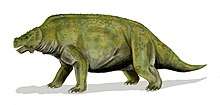 | |
| Home era | Permian |
| First appearance (Primeval) | Episode 1.1 |
| Last appearance (Primeval) | Episode 2.7 |
| Humans killed | 2 |
| Returned to era? | Episode 1.1 – Yes Episode 2.7 – Most likely killed by the other creatures in Oliver's prison. |
Scutosaurus was a genus of armour-covered Permian period pareiasaur, loosely related to the turtles. Its genus name refers to large plates of bony scutes (osteoderms) set in the skin, as a defence against predators. But the most unusual thing about them were the heavy skulls ornamented with strange knobs and ridges. It was of a very heavy build, almost rhinoceros-like. Unlike most reptiles, held its legs underneath its body with stubby toes to support its great weight.
A Scutosaurus first appears in Episode 1.1, and was the first prehistoric creature Connor, Nick, Stephen and Claudia ever saw (and the third one Abby sees after Rex and a Gorgonopsid). The team discover it in the Forest of Dean; they also see an Anomaly for the first time when the Scutosaurus then leads them to it, returning to its own time period. Nick and Captain Ryan see several of them after travelling through the Anomaly in question later in the same episode, then again after going through it a second time in Episode 1.6. In Episode 2.6, it is revealed that Oliver's men somehow captured two Scutosaurus and that they have become part of Oliver's creature army; they escape along with the other creatures after Nick tricks Oliver into freeing them and one is encountered by Connor, Abby, Jenny and Caroline; they use it to kill two of Oliver's armed men by provoking it to move forwards, trampling the two men to death. Although both of them return to the prison after being lured there along with the other creatures by Nick, Helen and Stephen, they almost certainly played no part whatsoever in Stephen's subsequent death as they were established as non-aggressive animals. It is assumed that after killing Stephen, the more aggressive creatures then turned on and killed each other, presumably killing the two Scutosaurus in the process.
These fearsome-looking animals were in fact inoffensive herbivores, which were well adapted to the dry conditions which covered much of Pangaea at that time. A social animal, they migrated in large groups.[3] The leaf-shaped multi-cusped teeth resemble those of iguanas, caseids, and other reptilian herbivores. This dentition, together with the deep capacious body which would have housed an extensive digestive tract. When in the past, they see several more Scutosaurus roaming a desert.[8]
Although initially described correctly as a pareiasaur, this species is from then on called a dinosaur throughout the episode in which it appears. Although based on the heavily armoured species called Scutosaurus kapinski that lived about 250 million years ago in Russia, the size of the Scutosaurus in the series is exaggerated.[1] It is described as at least "five or six tons" in weight, about as big as an elephant. In fact the actual Scutosaurus was much smaller, no more than 3 m (10 ft) in length. They appear locked up at the end of episode 2.7.
Shrew-like Creature
| Shrew | |
|---|---|
| Home era | Late Cretaceous |
| Appears in | Extinction Event |
| Number | 2 captured in the present |
In a small building used by the Russian anomaly team used for captured specimens, Cutter observes a pair of small shrew-like creatures scuttling around in a tank, while explaining to Abby how the mammals inherit the Earth after the K-T Event.
Silurian scorpion
| Silurian scorpion | |
|---|---|
| Home era | Silurian |
| First appearance (Primeval) | Episode 2.5 |
| Last appearance (Primeval) | Episode 2.7 |
| Number | 2 in modern era |
| Humans killed | 6 |
| Returned to era? | Episode 2.5 — already in its own time. Episode 2.7 — 1 Killed in a fight and 1 caught by Stephen. |
The Silurian scorpion is a prehistoric creature from the Silurian that grows to immense sizes, and is a variety of animal similar to Brontoscorpio. They have a long whip-like tail, spikes on the foreclaws and a flattened body, similar to modern day whip scorpions. The scorpions never come through the anomaly in their first appearance, but did in the second-season finale, along with many other creatures. They are probably reimagined from the ones in Walking with Monsters by the producers to make them bigger and more frightening. They hunt by sensing surface vibrations and burrowing underground, similar to the giant worms from the film Tremors. Their main food source appears to be the Silurian millipedes. In reality, scorpions of this size would not be able to breathe, let alone move about.
The scorpions made a reappearance in episode 2.7. One of them was released onto a crowded beach by Oliver Leek to show his power, where it killed two tourists and scared everyone else away. Stephen Hart set out to deal with it on his own, and harpooned it below a bridge. The still alive creature was left to be collected at leisure. Its fate was unknown, but presumably it was killed.
They appear in a flashback in episode 3.2, when Cutter recognises the Cleaner and thought he was killed by the scorpions. They are referred to as "Silurian scorpions" in the episode, but they are listed as "giant scorpion" on the Primeval official websites.
Smilodon
| Smilodon | |
|---|---|
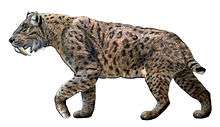 | |
| Home era | Pleistocene |
| First appearance (Primeval) | Episode 2.3 |
| Last appearance (Primeval) | Episode 2.7 |
| Number | 1 |
| Humans killed | 5 |
| Returned to era? | Episode 2.3 – No, kept by Oliver Leek Episode 2.7 – Presumably killed |
Smilodon is a vicious carnivorous sabre-toothed cat that lived in the Pleistocene in both North and South America. They are commonly and incorrectly called "sabre toothed tigers" where, in truth, all modern day tigers evolved from a different line.
A fully-grown Smilodon weighed approximately 200 kg (440 lb) and had a short tail, powerful legs, and a large head. The cats have two huge canine teeth, about 17 cm (7 in) long, that are used to kill prey by suffocation. The jaws could open to about 120 degrees in order to use these fangs to deadly effect. They would die out due to climate change.
Smilodon was mentioned in episode 1.4 by Helen Cutter as "sabre-toothed killers". However, she apparently lied when she claimed they would come through at that point, and escaped through the Spaghetti Junction. They are also seen, in skeleton form, in Nick's office.
A Smilodon appeared for the first time in episode 2.3, where it is responsible for a number of deaths at a theme park. When the team hear of this, Connor wonders why the Anomaly detector he has recently built didn't detect an Anomaly in the theme park; it is later revealed that the Smilodon had came through its Anomaly as a cub years before the events of the episode, and had been kept as a pet by a ranger called Valerie who had lost control of it as it became more aggressive and turned man-eater upon maturing; she was certain that her pet would never hurt her after all she had done for it over the years, but was proved wrong when it later killed her. At the end of the episode, Oliver claims the cat is dead, killed by an apparent heart attack after being tranquillised; Nick questions how this could have happened when it was a perfectly healthy animal. Oliver is revealed to have been lying in episode 2.7, where it is revealed he has built up his own army of creatures that his men have kidnapped from their own time and that the Smilodon is now one of the creatures in his army. He tries to use it to kill Connor, Abby, Jenny and Caroline, but Nick tricks him into opening the prison and the Smilodon escapes. It is later lured back to the prison along with the other creatures by Nick, Helen and Stephen; it then participates in killing Stephen. It is assumed that the creatures turned on and killed each other after killing Stephen and that the Smilodon, and the rest of Oliver's creatures, are all dead.[22]
Spinosaurus
| Spinosaurus | |
|---|---|
 | |
| Home era | Late Cretaceous |
| First appearance (Primeval) | Episode 4.1 |
| Last appearance (Primeval) | Episode 5.5 |
| Number | 1 |
| Returned to era? | Possibly Anomaly time unknown |
The Spinosaurus is the largest carnivorous dinosaur, weighing 4–20 t (4–20 long tons) and 18 m (59 ft) in length. It lived in Africa in the late Cretaceous. It is bipedal has a large "sail" on its back, though the one in the show included an additional mini sail on its tail.
In episode 4.1, a Spinosaurus is stalking Connor and Abby in the Cretaceous when the pair open an anomaly to the present using Helen's anomaly device. Abby lures a raptor towards the territorial Spinosaurus to distract it, and the larger dinosaur wins the fight while the two slip through the anomaly. When the anomaly was accidentally unlocked it came through and rampaged through the city, and was lured into an arena to be contained. Connor attempted to open another anomaly as Abby distracted it with lights and music and Becker and his men brought it down with their new EMDs. However it got back up and tried to attack Connor and Matt who were hanging from the ceiling, and it swallows the anomaly device and disappears into the anomaly created by it inside the Spinosaurus' stomach.
Spinosaurus was seen again in Episode 5.5, though this was stock from 4.1.
Stegosaurus
| Stegosaurus | |
|---|---|
 | |
| Home era | Late Jurassic |
| Appears in | Series 4 webisode 1 |
| Number | 1 (at least) |
Stegosaurus is the largest and most famous member of the Stegosaurid family, growing up to 9 m (30 ft) in length and more than capable of defending itself from predators with the four spikes on the end of its tail. A row of plates along its back, its most recognisable feature, may have been used as a cooling system in hot weather or to flash colour that could be used to entice mates or threaten enemies and predators.
Series 4 webisode 1 includes CCTV footage of a Stegosaurus causing havoc in the House of Commons during the time between Series 3 and 4. However this was not a real Stegosaurus, the CG model was that of the Embolotherium, re-used with close up footage. It is never revealed what happened to the Stegosaurus after its rampage through the House of Commons, but it had certainly been dealt with somehow by the time the events of Series 4 began.
Swimming Theropod
| "Swimming Theropod" | |
|---|---|
| Species | Balaur |
| Home era | Cretaceous (Maastrichtian Epoch) |
| First appearance (Primeval) | Episode 5.2 |
| Humans killed | 2 |
| Returned to era? | Yes, then eaten by a Liopleurodon |
A juvenile theropod was found unconscious in the North Sea and taken on board a naval submarine. After awakening, it attacked and killed a crewman. It was stunned by Abby and Connor, and then expelled through a torpedo-like tube into the Jurassic seas where it was eaten by a Liopleurodon.
T
Therocephalian
| Therocephalia | |
|---|---|
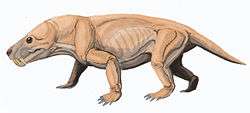 | |
| Home era | Permian |
| First appearance (Primeval) | Episode 4.4 |
| Number | 20+ |
| Humans killed | 2 |
| Returned to era? | Not shown, most had been gassed by smoke bombs. |
Therocephalians are an extinct suborder of carnivorous eutheriodont therapsids that lived from the middle and late Permian into the Triassic. Therocephalians ("beast-heads") are named after their large skulls, which, along with the structure of their teeth, suggest that they were successful carnivores. Like other non-mammalian synapsids, therocephalians are described as mammal-like reptiles, although in fact, Therocephalia is the group most closely related to the cynodonts, which gave rise to the mammals. The earlier therocephalians were in many respects as primitive as the gorgonopsids, but they did show certain advanced features. The discovery of maxilloturbinal ridges in some specimens suggests that at least some therocephalians may have been warm-blooded.
A species of Therocephalian appears in episode 4.4. Numerous creatures the size of a large dog come through an anomaly at a school, and kill a teacher and a female student. Matt, Becker, and Connor deal with the venomous creatures, and Becker was bitten by one of the venomous creatures to paralyse him, but later recovered.
Thylacosmilus
| Thylacosmilus | |
|---|---|
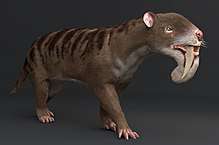 | |
| Home era | Plio-Pleistocene |
| Appears in | Shadow of the Jaguar |
| Number | 6+ |
| Humans killed | 40+ |
| Returned to era? | Four return, one killed by the SAS members, another by Future Bird |
Thylacosmilus was a pouched carnivore, resembling a sabre-toothed cat, that lived in South America 2 million years ago. It had a long, curving chin and a large pair of sabre teeth used for killing its prey. Thylacosmilus would become extinct due to being outcompeted by true sabre-tooth cats such as Smilodon.
In Shadow of the Jaguar, the first known anomaly to open overseas is in a biological reserve in the Peruvian rainforest and allows a pack of Thylacosmilus access to the modern world. They proceed to go on the rampage, wiping out several small villages, killing one of the sons of a senior man to Sir James Lester (Sir Charles), killing a sloth and killing several members of the SAS. A second pride of six Thylacosmilus are followed and some are killed by the SAS. It turns out that the Thylacosmilus are under the control of a creature from the future, which is using pheromones to control the pack's instinct and use them like hunting hounds. After the team disrupt the bird's control, the Thylacosmilus flee in terror back through the anomaly, just before it closes.
Torosaurus
| Torosaurus | |
|---|---|
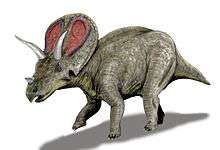 | |
| Home era | Late Cretaceous |
| Appears in | Extinction Event |
| Number | Large herds, several animals are killed |
In Extinction Event, several large groups of Torosaurus are seen. They are described as having huge frills, long horns and being aggressively unpredictable. In the first instance, a mother is killed whilst defending her calf and almost killing Connor in the process, and her calf is then killed by an unseen predator, which later turns out to be a Tyrannosaurus. Later on, a large herd is found by a river, and several animals are killed after a tank fires at them. The Torosaurus then attack the tanks and succeed in killing the driver.
Tree creeper
| Tree creeper | |
|---|---|
| Home era | Cretaceous |
| First appearance (Primeval) | Episode 4.3 |
| Last appearance (Primeval) | Episode 5.5 |
| Humans killed | 1 |
| Returned to era? | 4.3 – 1 (2 killed, but one stunned and fell back into the anomaly) 5.5 – Unknown |
Large (approx. 2 m high) Cretaceous[23] an ape-like arboreal dinosaur, the so-called "tree creeper," named by Emily Merchant, can climb easily using its claws and its long prehensile tail; it can also use its tail to snare its prey from above. It is a vicious carnivore with a head similar to that of a raptor, and legs featuring retractable sickle-claws. There is no current evidence to support what an actual one might look like, and the creature's actual species name, if any, is unknown.
Two tree creepers come through an anomaly in a London theatre in episode 4.3; another attacks Emily in the Cretaceous period before Matt rescues her. It gives chase back through the anomaly, only to be blasted back home by EMD fire. One of the two creatures who makes it through the anomaly is immediately shot by Becker, and the other falls to its death from a rooftop, after being chased there by Matt and Emily.
A tree creeper also appears in episode 5.5, when it comes through an anomaly that bursts open in the ARC car-park. For comic effect, It curiously investigates Lester's new Jaguar, but Lester comes to the car's rescue, bringing the creature down with a few EMD bursts. Whether this creature was sent back through the anomaly is unknown.
Triceratops
| Triceratops | |
|---|---|
 | |
| Species | Triceratops |
| Home era | Late Cretaceous |
| Appears in | Fire and Water Breakthrough |
| Number | Fire and Water – 2 Episode 1.9 – 1 |
| Humans killed | 0 |
| Returned to era? | Yes. |
A Triceratops came through an anomaly into a food by a skating park in Vancouver, British Columbia. Evan and Dylan followed it to Evan's old rival Howard Kanan who witnessed it charge at Evan late it was discovered that it was attracted by Dylan's red coat which they used to lure it back through the anomaly before it closed but unfortunately Howard followed it through and was marooned in the Cretaceous.
Troodon
| Troodon | |
|---|---|
.jpg) | |
| Home era | Late Cretaceous |
| Appears in | Extinction Event |
| Number | Several individuals, in both the past, and in the present. |
| Humans killed | 1 |
| Returned to era? | No |
Troodon are small carnivorous dinosaurs from the Late Cretaceous. They had the largest brain of any dinosaur.
Several are encountered in Extinction Event, where they are described as being intelligent, ruthless predators. They were first encountered feasting on the carcass of a dead Anatotitan, which had apparently been killed by shock, as a result of a meteor strike. Later, Jenny and Helen Cutter are in the Cretaceous period, and one of the SAS soldiers assigned to help them, Tim Jenkins, was dragged away by the Troodons, who ate him alive due to his crippling caused by a Dimetrodon. The rest of the team were too late to save him. Later in the present, a pack of Troodon showed up at the overturned car Jenny and Hemple were in. Jenny attempted to keep them at bay by using a large metal rod that she had found in the truck's wreck. However, one of the Troodon then knocked her down to the ground, and pinned her down, with its foot. Just as it was about to kill her, the car's ruptured fuel tank caught on fire, scaring the Troodons away.
Tyrannosaurus
| Tyrannosaurus | |
|---|---|
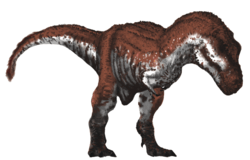 | |
| Species | Tyrannosaurus rex |
| Home era | Late Cretaceous |
| Appears in | Extinction Event |
| First appearance (Primeval) | Episode 5.5 |
| Number | Extinction Event – 2 Episode 5.5 – 1 |
| Humans killed | 20 |
| Returned to era? | No. Extinction Event – Male killed by female and female remains in Siberia. Episode 5.5 – Presumably. |
Tyrannosaurus is the most well known carnivorous dinosaur despite not being the largest.
In Extinction Event, a pair of Tyrannosaurus stalk the forests of Siberia, referred to many as Baba Yaga after a figure in Russian folklore. The female does most of the damage, killing a Torosaurus calf and several men before it encounters the male Tyrannosaurus, which has just arrived from the Cretaceous having killed a Pachycephalosaurus. The male and female fight, and the female kills her smaller rival. Surprisingly, the female Tyrannosaurus is not stopped, and merely returns to the dank, Russian forests, having killed her competitor.
In Episode 5.5 one rampaged through the streets of London, killing a few people until shot multiple times by Matt with an EMD knocking the creature out. This creature was the initial cause of the public's realisation of the anomalies.
U
Unknown Theropod
| Unknown theropod | |
|---|---|
| Home era | Cretaceous |
| First appearance (Primeval) | Episode 4.1 |
| Number | 1 |
The Unknown Theropod is an unknown species of large, tyrannosaur-like theropod dinosaur from the Cretaceous. Abby Maitland documented this theropod in her diary during the time when she and Connor Temple were marooned in the Cretaceous, and the document on the theropod was ultimately unintentionally burnt by Abby.
Utahraptor
| Utahraptor | |
|---|---|
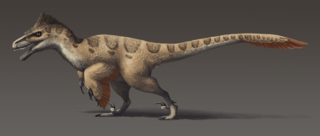 | |
| Home era | Early-Mid Cretaceous |
| Appears in | Primeval: New World |
| Number | 2 |
| Humans killed | 4 |
| Returned to era? | 1 returned, another fought a Pteranodon and caused the death of both combatants |
Utahraptor is the largest raptor in the dromaeosaurid family.
In The New World, Two Utahraptors came through an Anomaly to Stanley Park in the present, and stalked the Park. One raptor chased Evan Cross and Dylan Weir back through the Anomaly into the Cretaceous, and Evan and Dylan then returned through the Anomaly to the present. The anomaly then closed, leaving one Utahraptor still marooned in the present. The Utahraptor travelled to Vancouver, killing Tony Drake and a homeless man. It later returned to Stanley park where it battled a Pteranodon. the Utahraptor killed the Pteranodon, but then died of its injuries in the fight. The two carcasses were frozen at Cross Photonics.
V
Velociraptor
| Velociraptor | |
|---|---|
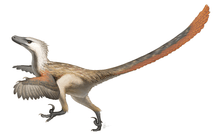 | |
| Home era | Late Cretaceous |
| Appears in | Fire and Water |
| First appearance (Primeval) | Episode 3.4 |
| Number | 1 in episode 3.4, 6 in Fire And Water |
| Returned to era? | Yes |
In episode 3.4, a huge anomaly opens, in an aeroplane hangar. Nigel Marven and a media team is called to investigate. A juvenile Velociraptor runs out of it and bites Nigel on the hand. It then runs back through the anomaly just before the Giganotosaurus comes through. Six Velociraptors came through an anomaly into a wet and rainy Maidenhead in Fire and Water. They were all returned but several were shot in the past when they tried to kill Becker and they did succeed in killing one of his colleagues, Jamie Weavers.
W
Worm
| Worm | |
|---|---|
| Home era | Pre-Cambrian |
| First appearance (Primeval) | Episode 2.2 |
| Last appearance (Primeval) | Episode 5.5 |
| Number | 40+ |
| Humans killed | 3 |
| Returned to era? | No. All killed, most by heat caused by a thermostat. |
Although many invertebrates are commonly called worms, the Primeval worms are very large carnivorous worms from some time before the oxygen catastrophe, 2.7 billion years ago. In reality such a creature is impossible – for any lifeform to grow that big it would need an atmosphere more energy-rich than the fog they live in and they would not be able to breathe let alone move in it. The worms have long retractable mouthparts, large enough to engulf a man, for feeding. These creatures were based on marine ragworms. The worms need movement to sense their prey, and can be fooled if a person stands still and throws an inanimate object[19]
In the episode, the worms cannot survive outside the "fog", which is first shown when Nick and Stephen trap the mouthparts in a door separating the fog: if separated from their natural atmosphere, oxygen, highly poisonous to them, kills them. The fog is the Pre-Cambrian atmosphere, which presumably comes through the anomaly. When they are faced with an increase of heat, they explode to spawn their young which then attempt to burrow into a living host. This life cycle is not dissimilar to the parasite. They can also spit a brown-coloured slime, which might be used to track or even attack their prey.[19]
It also reappears in a classroom during the convergence of the anomalies in Series 5.
They appear to resemble the Carnictis from the 2005 remake of King Kong
References
- Milne, Mike. "Primeval sees Framestore CFC's Creatures Leap into the 21st Century". Archived from the original on 15 March 2007.
- "Episode 1.5". Primeval. Season 1. Episode 5. 17 March 2007. ITV. ITV1.
- Henshall, Douglas. "Here be Monsters".
- "Episode 1.2". Primeval. Season 1. Episode 2. 17 March 2007. ITV. ITV1.
- "ITV Winter Spring Showreel". Archived from the original on 9 December 2008. Retrieved 23 November 2008.
- "Episode 1.4". Primeval. Season 1. Episode 4. 17 March 2007. ITV. ITV1.
- WALT BELCHER. (7 August 2008). Time Portal Drama In London Rips Open A Whole Batch Of Zoological Adventures. Tampa Tribune,2. Retrieved 29 October 2010, from ProQuest Newsstand. (Document ID: 1529629631).
- "Episode 1.1". Primeval. Season 1. Episode 1. 17 March 2007. ITV.
- "Episode 1.6". Primeval. Season 1. Episode 6. 17 March 2007. ITV. ITV1.
- "Episode 1.3". Primeval. Season 1. Episode 3. 17 March 2007. ITV. ITV1.
- Primeval creatures -Labyrinthodont Archived 27 January 2013 at Archive.today
- Cult|Primeval|Series 3|Winner revealed – ITV Drama Archived 16 June 2008 at the Wayback Machine
- Cult|Primeval|Series 3|Competition – ITV Drama Archived 28 May 2008 at the Wayback Machine
- "Episode 1.4". Primeval. Season 1. Episode 4. 3 March 2007. ITV. ITV1.
- "Series three Q&A with the creators of Primeval". Radiotimes.com. Retrieved 4 January 2011.
- "Cult – News – Flemyng, Rouass join 'Primeval' cast". Digital Spy. 14 April 2008. Retrieved 4 January 2011.
- "Primeval Series ITV: Interview with Tim Haines and Adrian Hodges". Douglashenshall.com. Retrieved 4 January 2011.
- "newseasonnewhorizons.com". newseasonnewhorizons.com. Archived from the original on 8 February 2011. Retrieved 4 January 2011.
- "Episode 2.2". Primeval. Season 2. Episode 2. 17 March 2008. ITV. ITV1.
- henshall, douglas. "Primeval Series 2 filmed in John Lewis".
- https://web.archive.org/web/20080430041534/http://primeval.tv/creatures.php. Archived from the original on 30 April 2008. Retrieved 27 August 2008. Missing or empty
|title=(help) - Primeval filming in Thorpe Park Archived 19 August 2007 at the Wayback Machine
- ITV (9 January 2011). "Primeval – Creatures". ITV. Retrieved 9 January 2011.